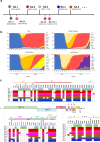Origin, virological features, immune evasion and intervention of SARS-CoV-2 Omicron sublineages
- PMID: 35853878
- PMCID: PMC9295084
- DOI: 10.1038/s41392-022-01105-9
Origin, virological features, immune evasion and intervention of SARS-CoV-2 Omicron sublineages
Abstract
Recently, a large number of severe acute respiratory syndrome coronavirus 2 (SARS-CoV-2) variants continuously emerged and posed a major threat to global public health. Among them, particularly, Omicron variant (B.1.1.529), first identified in November 2021, carried numerous mutations in its spike protein (S), and then quickly spread around the world. Currently, Omicron variant has expanded into more than one hundred sublineages, such as BA.1, BA.2, BA.2.12.1, BA.4 and BA.5, which have already become the globally dominant variants. Different from other variants of concern (VOCs) of SARS-CoV-2, the Omicron variant and its sublineages exhibit increased transmissibility and immune escape from neutralizing antibodies generated through previous infection or vaccination, and have caused numerous re-infections and breakthrough infections. In this prospective, we have focused on the origin, virological features, immune evasion and intervention of Omicron sublineages, which will benefit the development of next-generation vaccines and therapeutics, including pan-sarbecovirus and universal anti-CoV therapeutics, to combat currently circulating and future emerging Omicron sublineages as well as other SARS-CoV-2 variants.
© 2022. The Author(s).
Conflict of interest statement
The authors declare no competing interests.
Figures


References
-
- WHO. Classification of Omicron (B.1.1.529): SARS-CoV-2 Variant of Concern. https://www.who.int/news/item/26-11-2021-classification-of-omicron-(b.1.... (2021).
-
- Lineage List. https://cov-lineages.org/lineage_list (2022).
-
- GISAID. www.gisaid.org (2022).
Publication types
MeSH terms
Supplementary concepts
LinkOut - more resources
Full Text Sources
Other Literature Sources
Medical
Miscellaneous

